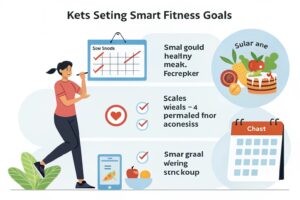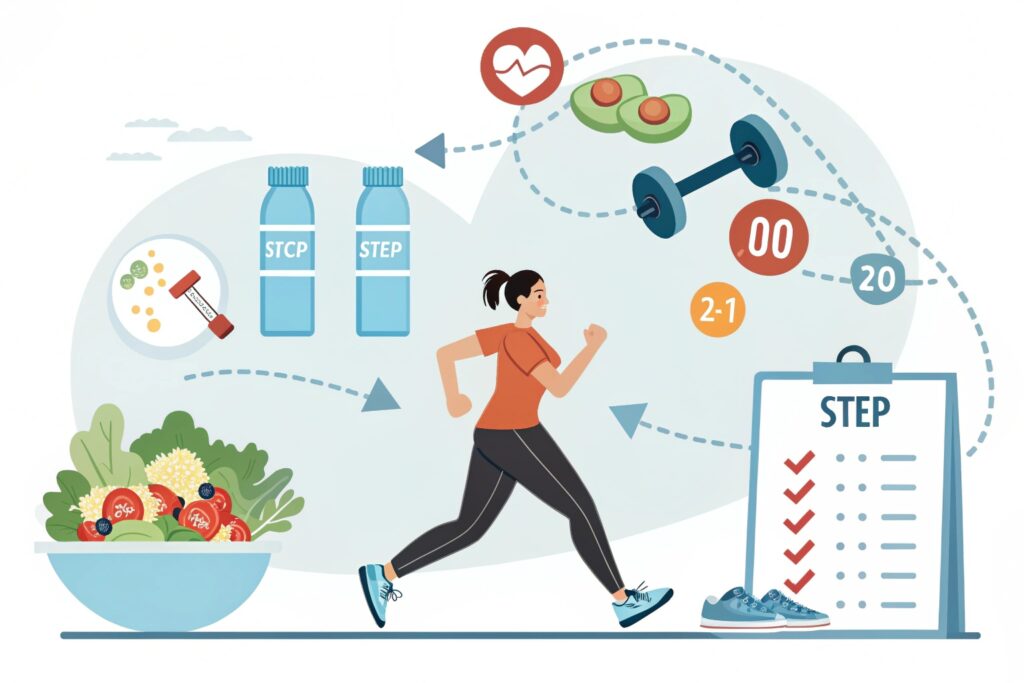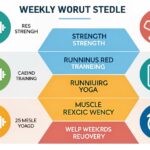Kick‑Start Your Weight‑Loss Journey : Embarking on a healthier lifestyle can feel overwhelming, especially when you’re bombarded with fad diets and conflicting advice. That’s why we’ve broken down the process into 10 Simple Steps to Kick‑Start Your Weight‑Loss Journey—a practical, science‑backed roadmap you can follow today. Whether you’re a busy professional, a stay‑at‑home parent, or anyone in between, these steps blend nutrition, movement, mindset, and sustainable habits so you can see results without sacrificing joy or sanity.
In this comprehensive guide, you’ll discover why each step matters, the research that supports it, and how to implement it in real life. We’ve drawn on peer‑reviewed studies, recommendations from the American Council on Exercise (ACE), and insights from registered dietitians to ensure you get trustworthy, actionable advice. Ready to transform the way you eat, move, and think? Let’s dive into the first two foundational steps before exploring the full 10‑step framework.
Step 1: Set a Realistic, Measurable Goal| Kick‑Start Your Weight‑Loss Journey

Why SMART Goals Matter
A vague aspiration like “lose weight” rarely translates into action. Instead, adopt the SMART framework—Specific, Measurable, Achievable, Relevant, and Time‑bound. For instance, “lose 1–2 lb per week for the next 12 weeks by reducing daily calories by 500 kcal and exercising 30 minutes, 5 days a week.” A 2020 meta‑analysis published in Obesity Reviews found that participants using SMART goals were **42 % more likely** to stay on track compared with those with ambiguous targets. Clear metrics help you monitor progress, adjust tactics, and stay motivated.
Creating Your Personal Baseline
Begin by calculating your Total Daily Energy Expenditure (TDEE) using a reputable calculator (e.g., the Mifflin‑St Jeor equation). Document current habits—what you eat, activity levels, sleep quality, and stressors. This baseline serves as a reference point for measuring change, just as a doctor would track blood pressure before prescribing medication. Tools like MyFitnessPal or Cronometer provide reliable calorie estimates and macro breakdowns, making the data collection straightforward and accurate.
Step 2: Master the Fundamentals of Calorie Deficit
Understanding Energy Balance
Weight loss fundamentally follows the principle of energy balance: calories consumed vs. calories expended. A sustainable deficit typically ranges from **10–20 %** of your TDEE, which translates to a 250‑500 kcal reduction for most adults. The National Institutes of Health (NIH) notes that this range supports steady fat loss while preserving lean muscle mass—crucial for long‑term metabolic health.
Practical Strategies to Reduce Calories
Portion control: Use the “hand method” (palm for protein, fist for vegetables, cupped hand for carbs) to keep portions in check without counting every gram.
Swap high‑calorie items: Replace sugary drinks with water or herbal tea; trade deep‑fried sides for roasted vegetables.
Mindful eating: Put away screens, chew slowly, and pause before the second helping. Research from the University of Pennsylvania indicates that mindful eating can cut daily intake by up to **15 %** for many participants.
Step 3: Prioritize Protein and Fiber
Protein is the cornerstone of satiety and muscle preservation. The Academy of Nutrition and Dietetics recommends **1.2–1.6 g of protein per kilogram of body weight** for active individuals seeking weight loss. A study in the *American Journal of Clinical Nutrition* (2018) demonstrated that higher protein diets reduced hunger hormones (ghrelin) and increased fullness hormones (GLP‑1) more than lower‑protein regimens.
Fiber works hand‑in‑hand with protein. Soluble fiber—found in oats, beans, and apples—forms a gel in the gut, slowing glucose absorption and extending satiety. Aim for **25–30 g of fiber** daily; a simple trick is to start meals with a salad or a cup of broth‑based soup, which can reduce overall calorie intake by **10‑15 %** according to Harvard Health.
Meal‑Prep Example
Breakfast: Greek yogurt (20 g protein) + mixed berries (5 g fiber) + a sprinkle of chia seeds.
Lunch: Grilled chicken breast (30 g protein) on top of quinoa (4 g fiber) with roasted broccoli (3 g fiber).
Snack: A small apple with 2 Tbsp almond butter (4 g protein).
Dinner: Baked salmon (22 g protein) with sweet potato wedges and sautéed kale (2 g fiber).
By structuring meals around protein‑rich foods and fiber‑dense vegetables, you’ll naturally curb cravings and sustain energy levels.
Step 4: Incorporate Balanced Movement
Cardio vs. Strength Training: Finding the Sweet Spot
While cardio burns calories during the activity, strength training builds lean muscle, which raises resting metabolic rate (RMR). A 2019 review in *Sports Medicine* found that participants who combined 150 minutes of moderate cardio with 2‑3 resistance sessions per week** lost **1.5 lb** more over 12 weeks compared with cardio alone. Think of cardio as the “fuel injector” and strength work as the “engine” that keeps burning calories long after you finish exercising.
Beginner‑Friendly Workouts
High‑Intensity Interval Training (HIIT):20 seconds of vigorous effort (e.g., sprinting, jump squats) followed by 40 seconds of rest; repeat 8–10 times. Total session: 10 minutes. HIIT can elevate post‑exercise oxygen consumption (EPOC) up to 6‑8 %of total daily energy expenditure.
Resistance Circuit:3 rounds of 10‑12 reps each: body‑weight squats, push‑ups, dumbbell rows, and plank holds (30 seconds). Minimal equipment, high functional benefit.
Low‑Impact Options: Brisk walking, cycling, or swimming for 30‑45 minutes, 4‑5 times weekly, ideal for joint‑friendly cardio.
Mixing modalities prevents plateaus, promotes overall fitness, and keeps motivation high.
Step 5: Optimize Sleep and Stress Management
The Sleep‑Weight Connection
Insufficient sleep disrupts leptin and ghrelin, hormones that regulate hunger. The CDC reports that adults sleeping <7 hours are **30 % more likely** to be obese. Aim for **7‑9 hours** of quality sleep; establish a bedtime routine, limit blue‑light exposure an hour before bed, and keep the bedroom cool (around 65 °F). Even a modest “sleep extension” of 30 minutes per night can improve insulin sensitivity and reduce late‑night snacking.
Stress Reduction Techniques
Chronic cortisol elevation encourages visceral fat storage. Incorporate stress‑relief practices such as:
– **Mindful breathing:** 4‑7‑8 technique (inhale 4 sec, hold 7 sec, exhale 8 sec).
– **Progressive muscle relaxation:** Systematically tense and release muscle groups for 10 minutes daily.
– **Physical activity:** Even a 10‑minute walk can lower cortisol by up to **15 %** (study, *Psychoneuroendocrinology*, 2021).
Consistency is key—track stress levels in a journal and notice patterns that affect eating habits.
Step 6: Harness the Power of Tracking & Accountability
Digital Tools vs. Pen‑and‑Paper
Modern technology offers seamless tracking. Apps like MyFitnessPal, Lose It!, or Cronometer let you log meals, macros, and activity in seconds. For those who prefer analog, a simple bullet journal with daily logs can be equally effective; a 2022 survey by the International Journal of Behavioral Nutrition found **no significant difference** in weight loss outcomes between digital and paper trackers, emphasizing that consistency matters more than medium.
Accountability Partners & Communities
Sharing goals with a friend, joining a Facebook “weight‑loss” group, or hiring a certified health coach boosts adherence. The *Journal of Consulting and Clinical Psychology* (2019) reported a **40 % higher success rate** for participants who reported weekly progress to an accountability partner versus those who worked alone. Choose a partner whose schedule aligns with yours, and set weekly “check‑in” calls or messages.
Data‑Driven Adjustments
Every 2‑4 weeks, review your logs: Did you meet your calorie target? Were you consistent with workouts? Identify trends—perhaps you’re under‑estimating carbs at lunch or skipping strength sessions on rainy days. Use the “plan‑do‑study‑act” (PDSA) cycle: tweak one variable (e.g., increase protein by 10 g) and observe the impact for a fortnight before making another adjustment.
Step 7: Hydration—The Unsung Hero
How Water Influences Metabolism
Drinking water can temporarily boost metabolism by **3‑4 %** (approximately 30 kcal per 500 mL) according to a 2017 study in *JAMA Internal Medicine*. Moreover, adequate hydration reduces false hunger signals; up to **20 %** of reported “snack cravings” are actually thirst.
Practical Hydration Hacks
– Carry a 1‑liter reusable bottle; sip a quarter before each meal.
– Infuse water with lemon, cucumber, or mint for flavor without added sugars.
– Set phone reminders (e.g., every 90 minutes) to take a sip.
Aim for **2‑3 liters** per day for women and **3‑4 liters** for men, adjusting for activity level and climate.
Step 8: Choose Whole Foods Over Processed Options
Why Whole Foods Promote Fat Loss
Whole foods—vegetables, fruits, legumes, nuts, lean meats, and minimally processed grains—contain higher nutrient density, fiber, and water content, all of which increase satiety per calorie. A 2015 randomized trial in *The Lancet* showed participants who switched from a processed‑food diet to a whole‑food diet lost **2.5 lb** more over 8 weeks while maintaining the same calorie intake.
Swap List for Everyday Meals
| Processed Item | Whole‑Food Alternative |
|—————-|————————|
| White bread | 100 % whole‑grain sprouted bread |
| Sugary cereal | Steel‑cut oats with berries |
| Store‑bought salad dressing | Olive oil + balsamic vinegar |
| Frozen pizza | Homemade cauliflower crust pizza |
| Packaged snack bars | Handful of almonds + an apple |
Gradual swaps prevent overwhelm and cultivate a pantry of nutritious options that support your weight‑loss journey.
Step 9: Practice Flexible, Not Rigid, Eating
The 80/20 Rule
Rigid restriction often leads to binge cycles. The 80/20 principle—eat nutrient‑dense foods 80 % of the time, allow flexibility 20 %—creates psychological freedom while sustaining a calorie deficit. A 2021 study in *Nutrition Journal* found that participants following an 80/20 approach reported **30 % higher adherence** and **lower stress** compared with strict “all‑or‑nothing” diets.
Implementing Flexibility
– Schedule “re‑feed” meals once a week where you enjoy a favorite treat within portion limits.
– Use the “plate method”: half vegetables, quarter lean protein, quarter whole carbs.
– Practice “mindful indulgence”: savor each bite, eat slowly, and stop when you’re comfortably full.
Flexibility fosters long‑term sustainability, turning weight loss into a lifestyle rather than a temporary fix.
Step 10: Review, Celebrate, and Reset
Measuring Success Beyond the Scale
Weight is just one metric. Track body measurements (waist, hips), body composition (via bio‑impedance or DEXA scans), fitness improvements (e.g., increased reps or faster run times), and how you feel mentally. A 2020 systematic review in *Obesity* highlighted that **non‑scale victories** improve motivation and reduce dropout rates.
Celebration Strategies
– Reward progress with non‑food treats: a new workout outfit, a massage, or a weekend hike.
– Share milestones on social media or with your accountability group to reinforce achievement.
– Keep a “wins journal” where you write down weekly successes, no matter how small.
Reset for the Next Phase
After 8‑12 weeks, reassess your TDEE (weight loss will have lowered your basal metabolic rate) and adjust calorie targets accordingly. Consider introducing a new fitness modality—like yoga or Pilates—to keep your routine fresh. The key is continuous learning and adaptation, ensuring the journey remains engaging and effective.
Conclusion: Your 10‑Step Blueprint to Lasting Weight Loss
You now have a research‑backed, step‑by‑step plan that blends nutrition, movement, mindset, and accountability. By setting SMART goals, mastering calorie deficit, prioritizing protein and fiber, moving intelligently, optimizing sleep, tracking meticulously, staying hydrated, choosing whole foods, embracing flexibility, and celebrating progress, you’re equipped to turn the phrase “kick‑start your weight‑loss journey” into a lived reality.
Ready to take action? Start today by logging your baseline numbers and committing to Step 1. Share your goals in the comments below or on social media with the hashtag #KickStart10Steps—your story could inspire others! If you found this guide helpful, explore our related articles on “Meal‑Prep Hacks for Busy Professionals” and “Effective Home HIIT Workouts”. Together, let’s build a healthier community, one simple step at a time.



